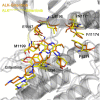Deciphering the Mechanism of Gilteritinib Overcoming Lorlatinib Resistance to the Double Mutant I1171N/F1174I in Anaplastic Lymphoma Kinase
- PMID: 35004700
- PMCID: PMC8733690
- DOI: 10.3389/fcell.2021.808864
Deciphering the Mechanism of Gilteritinib Overcoming Lorlatinib Resistance to the Double Mutant I1171N/F1174I in Anaplastic Lymphoma Kinase
Abstract
Anaplastic lymphoma kinase (ALK) is validated as a therapeutic molecular target in multiple malignancies, such as non-small cell lung cancer (NSCLC). However, the feasibility of targeted therapies exerted by ALK inhibitors is inevitably hindered owing to drug resistance. The emergence of clinically acquired drug mutations has become a major challenge to targeted therapies and personalized medicines. Thus, elucidating the mechanism of resistance to ALK inhibitors is helpful for providing new therapeutic strategies for the design of next-generation drug. Here, we used molecular docking and multiple molecular dynamics simulations combined with correlated and energetical analyses to explore the mechanism of how gilteritinib overcomes lorlatinib resistance to the double mutant ALK I1171N/F1174I. We found that the conformational dynamics of the ALK kinase domain was reduced by the double mutations I1171N/F1174I. Moreover, energetical and structural analyses implied that the double mutations largely disturbed the conserved hydrogen bonding interactions from the hinge residues Glu1197 and Met1199 in the lorlatinib-bound state, whereas they had no discernible adverse impact on the binding affinity and stability of gilteritinib-bound state. These discrepancies created the capacity of the double mutant ALK I1171N/F1174I to confer drug resistance to lorlatinib. Our result anticipates to provide a mechanistic insight into the mechanism of drug resistance induced by ALK I1171N/F1174I that are resistant to lorlatinib treatment in NSCLC.
Keywords: anaplastic lymphoma kinase; drug resistance; molecular dynamics simulations; non-small cell lung cancer; targeted therapy.
Copyright © 2021 Liang, Wang, Qi, Liu, Li, Lu, Mou and Chen.
Conflict of interest statement
The authors declare that the research was conducted in the absence of any commercial or financial relationships that could be construed as a potential conflict of interest.
Figures










Similar articles
-
Dissecting the role of ALK double mutations in drug resistance to lorlatinib with in-depth theoretical modeling and analysis.Comput Biol Med. 2024 Feb;169:107815. doi: 10.1016/j.compbiomed.2023.107815. Epub 2023 Dec 7. Comput Biol Med. 2024. PMID: 38128254
-
In-depth theoretical modeling to explore the mechanism of TPX-0131 overcoming lorlatinib resistance to ALKL1196M/G1202R mutation.Comput Biol Med. 2024 Dec;183:109265. doi: 10.1016/j.compbiomed.2024.109265. Epub 2024 Oct 15. Comput Biol Med. 2024. PMID: 39405725
-
Impact of compound mutations I1171N + F1174I and I1171N + L1198H on the structure of ALK in NSCLC pathogenesis: atomistic insights.J Biomol Struct Dyn. 2023 Jul;41(10):4735-4743. doi: 10.1080/07391102.2022.2072390. Epub 2022 May 5. J Biomol Struct Dyn. 2023. PMID: 35514136
-
Transformation of NSCLC to SCLC harboring EML4-ALK fusion with V1180L mutation after alectinib resistance and response to lorlatinib: A case report and literature review.Lung Cancer. 2023 Dec;186:107415. doi: 10.1016/j.lungcan.2023.107415. Epub 2023 Oct 28. Lung Cancer. 2023. PMID: 37907052 Review.
-
Lorlatinib for the treatment of anaplastic lymphoma kinase-positive non-small cell lung cancer.Expert Rev Clin Pharmacol. 2019 Mar;12(3):173-178. doi: 10.1080/17512433.2019.1570846. Epub 2019 Jan 30. Expert Rev Clin Pharmacol. 2019. PMID: 30657349 Review.
Cited by
-
Deciphering the molecular choreography of Janus kinase 2 inhibition via Gaussian accelerated molecular dynamics simulations: a dynamic odyssey.J Comput Aided Mol Des. 2024 Feb 7;38(1):8. doi: 10.1007/s10822-023-00548-8. J Comput Aided Mol Des. 2024. PMID: 38324213
-
The Role of Conformational Dynamics and Allostery in the Control of Distinct Efficacies of Agonists to the Glucocorticoid Receptor.Front Mol Biosci. 2022 Jul 7;9:933676. doi: 10.3389/fmolb.2022.933676. eCollection 2022. Front Mol Biosci. 2022. PMID: 35874618 Free PMC article.
-
Autopromotion of K-Ras4B Feedback Activation Through an SOS-Mediated Long-Range Allosteric Effect.Front Mol Biosci. 2022 Apr 8;9:860962. doi: 10.3389/fmolb.2022.860962. eCollection 2022. Front Mol Biosci. 2022. PMID: 35463958 Free PMC article.
-
Insights into the Allosteric Effect of SENP1 Q597A Mutation on the Hydrolytic Reaction of SUMO1 via an Integrated Computational Study.Molecules. 2022 Jun 28;27(13):4149. doi: 10.3390/molecules27134149. Molecules. 2022. PMID: 35807394 Free PMC article.
-
Mechanistic Insights into the Mechanism of Inhibitor Selectivity toward the Dark Kinase STK17B against Its High Homology STK17A.Molecules. 2022 Jul 21;27(14):4655. doi: 10.3390/molecules27144655. Molecules. 2022. PMID: 35889528 Free PMC article.
References
-
- Abraham M. J., Murtola T., Schulz R., Páll S., Smith J. C., Hess B., et al. (2015). Gromacs: High Performance Molecular Simulations through Multi-Level Parallelism from Laptops to Supercomputers. SoftwareX 1-2, 19–25. 10.1016/j.softx.2015.06.001 - DOI
-
- Anggayasti W. L., Ogino K., Yamamoto E., Helmerhorst E., Yasuoka K., Mancera R. L. (2020). The Acidic Tail of HMGB1 Regulates its Secondary Structure and Conformational Flexibility: A Circular Dichroism and Molecular Dynamics Simulation Study. Comput. Struct. Biotechnol. J. 18, 1160–1172. 10.1016/j.csbj.2020.05.012 - DOI - PMC - PubMed
LinkOut - more resources
Full Text Sources

